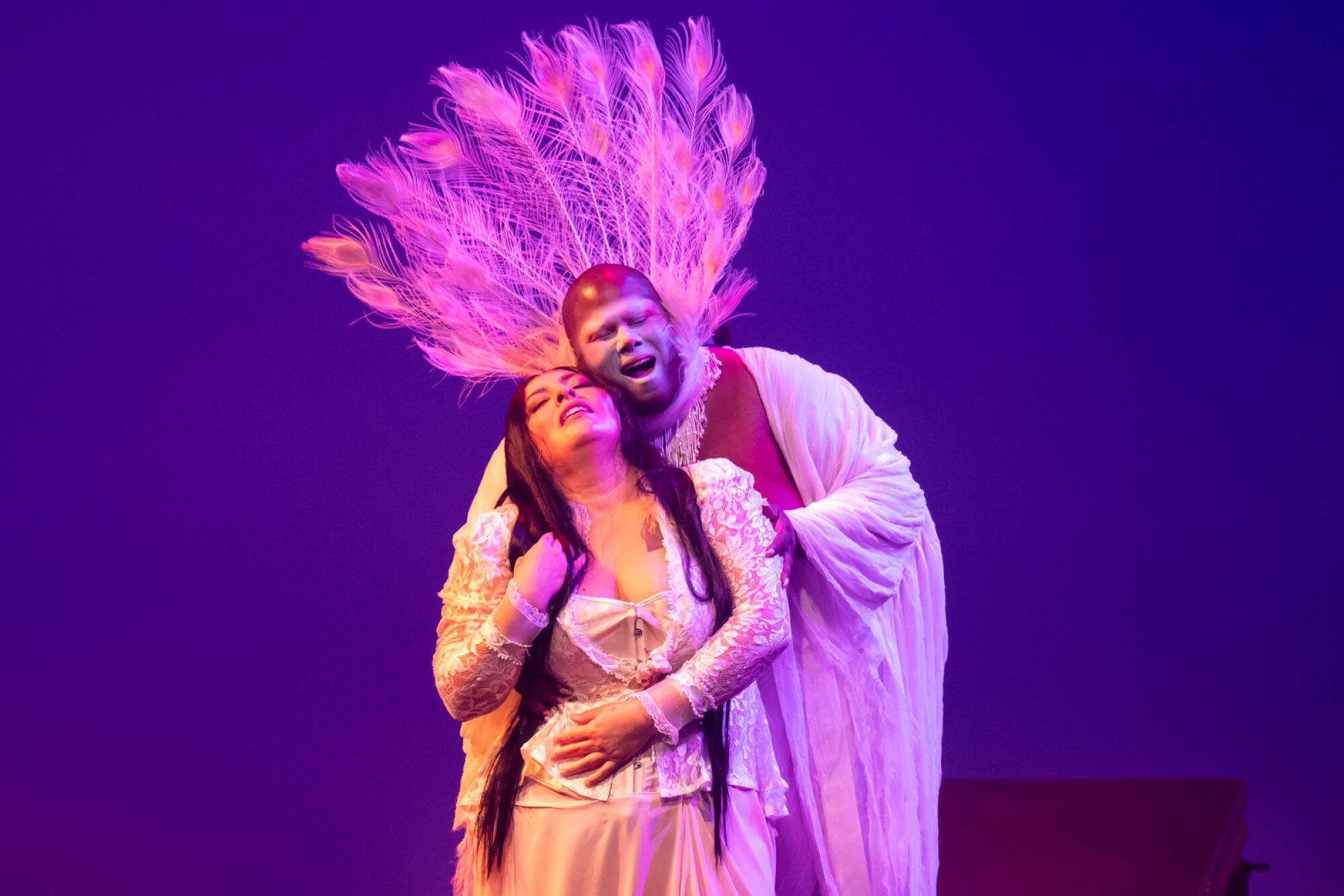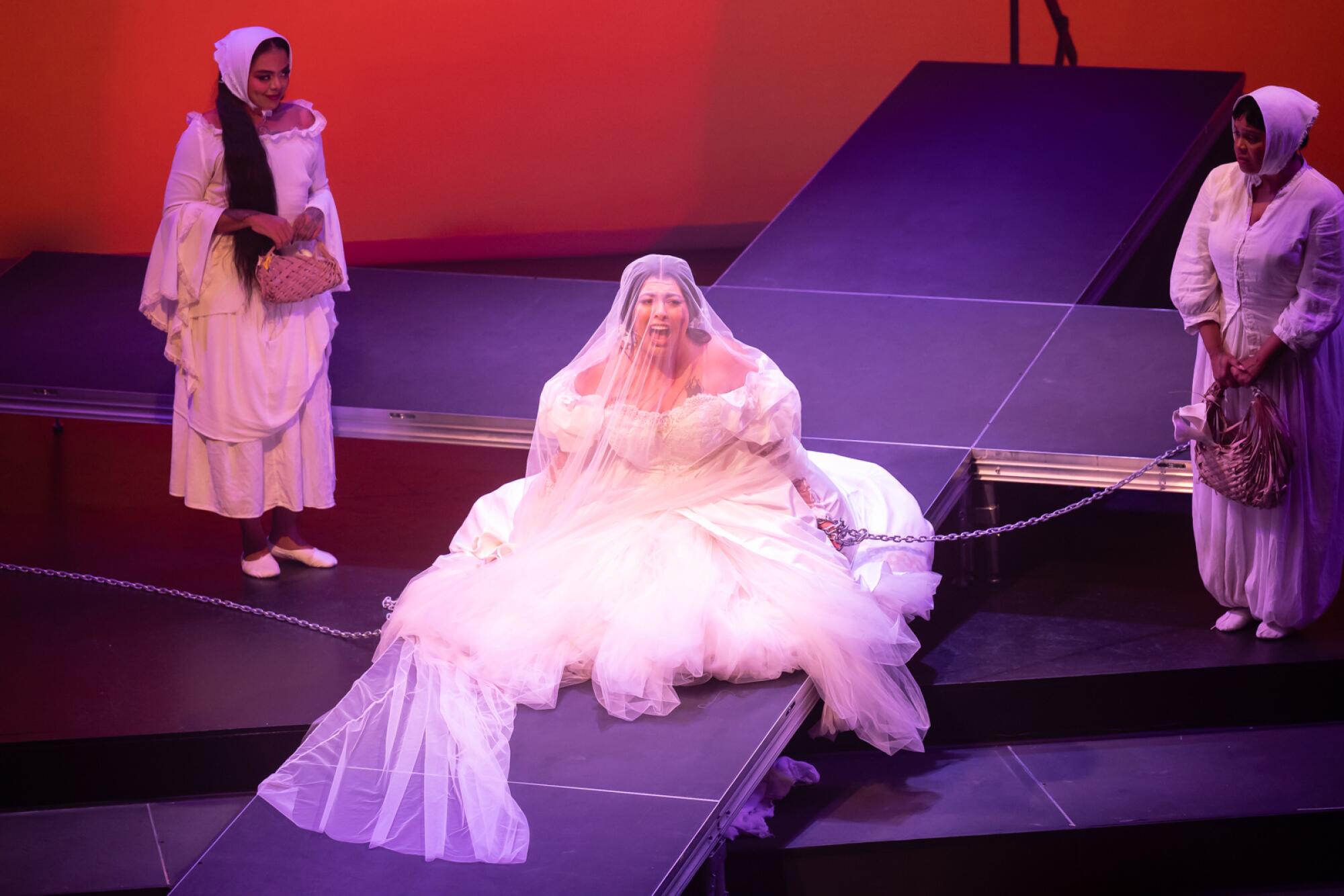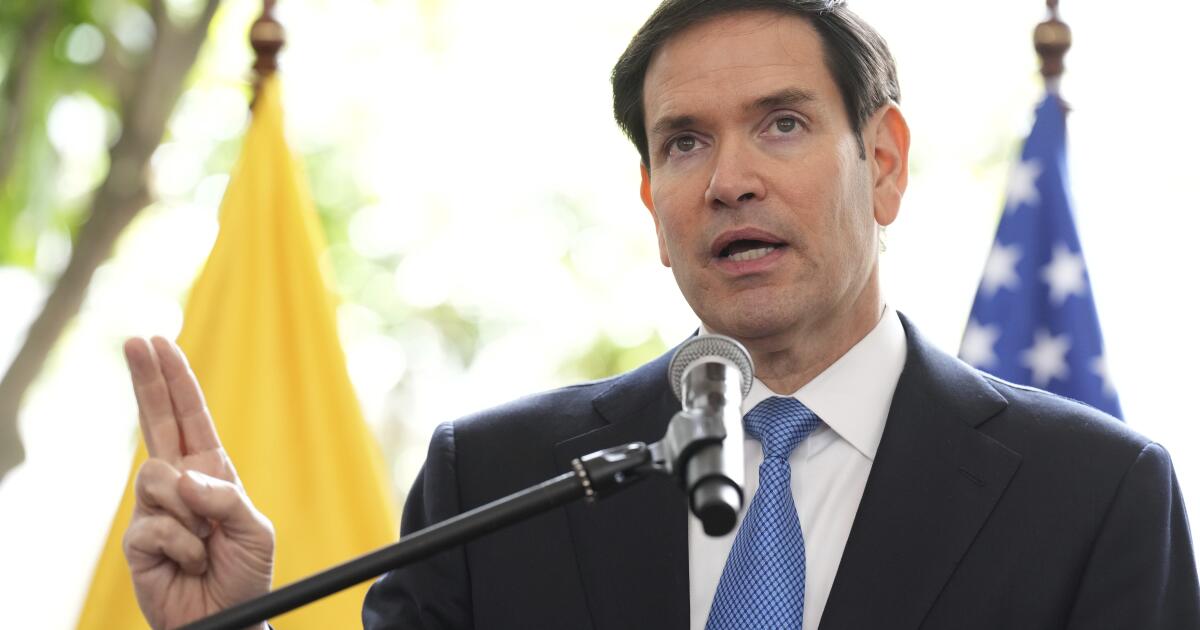San Cha upends telenovela archetypes in experimental new opera, ‘Inebria me’
For L.A.-based musician, composer and artist San Cha, the Spanish language is a creative gold mine. “One of my favorite Spanish words is ‘embriágame,’ which I think the direct translation is ‘make me drunk’ or ‘intoxicate me,’” she says. “I love that word. I think there’s a song by Thalía that has that word, it’s called ‘Piel Morena,’ and every time she said that, I’m like — ‘That’s it!’”
San Cha is speaking of her latest work, “Inebria me,” ahead of its Los Angeles premiere Thursday at REDCAT, inside the Walt Disney Concert Hall complex. “Inebria me” is a 90-minute experimental opera that expands on her critically acclaimed 2019 ranchera fusion album, “La Luz de la Esperanza.” San Cha stars as Dolores, a humble bride to the much wealthier Salvador, whose jealousy turns deadly; enter Esperanza, a genderless spirit of empowerment, who helps light Dolores’ path to freedom.
Having gone from singing rancheras in the restaurants of Mexico City to experimenting in underground drag scenes in the Bay Area, San Cha has developed a knack for synthesizing disparate influences that result in visually arresting and thought-provoking work. Born Lizette Gutierrez in San Jose to Mexican immigrant parents, San Cha grew up offsetting her intense Bible study by binging on telenovelas after school. It shows in “Inebria me,” where she employs the classic narrative structure of the telenovela, but with a queer twist. “I wanted to hold [onto] the queerness of [the story] and the religious aspects of it,” she says.
The opera is the latest of San Cha’s collaborative efforts. She’s previously linked up with an array of artists — including La Doña, Rafa Esparza, Yesika Salgado and even country singer Kacey Musgraves, who featured San Cha in a pivotal moment from her 2021 visual album, “Star-Crossed.” Darian Donovan Thomas also stars in “Inebria me,” alongside Stefa Marin Alarcon, Lu Coy, Kyle Kidd, Carolina Oliveros and Phong Tran.
In our latest interview, she discusses developing her music for the stage and what it took to build the confidence to advocate for her original vision on her own.
This interview has been edited and condensed for clarity.

San Cha performs with Darian Donovan Thomas on Sept. 5 at the Winningstad Theatre in Portland, Ore.
(Jingzi Zhao)
When did the idea to adapt “La Luz de la Esperanza” come to you?
It actually came to me in 2023 or 2024 when I partnered with the National Performance Network for this grant. I started talking with the Portland Institute for Contemporary Art, which was already on board, and the Performance Space New York. Like, what would I do to adapt this work?
Did you have experience in traditional theater growing up?
No, I didn’t. And I also didn’t watch too many movies. I missed out on a lot of those very American experiences. People would be like, “Do you know this movie?’ And “It’s like a classic,” and it’s like “No.” I was really sheltered, you know, “I’m over here in Bible study” kind of s—.
Has anyone in your family seen this piece? If so, what was their feedback?
My parents saw a trial version of this piece in San Jose, my hometown. They saw the PG-13 version, which is what I’d like to say, and my mom was confused; I don’t even know how my dad felt. My mom’s one comment was, “You didn’t sing rancheras. Everyone wants you to sing rancheras.” And I was like, “Oh, my God.” So they also came to the closing night with a big group, and I sang the rancheras for them at the end.
How would you relate “Inebria me” to what’s considered a “traditional” opera?
I would say it has a very clear narrative … everything is sung, except for the parts [where] the Man [is] talking or speaking.
I sing rancheras [and] that kind of blends into operas. I didn’t grow up being an opera singer, or wanting to be an opera singer, but somehow it developed in that direction. In this, we get to be all the things: a little hardcore, a little pop, a little mix with opera.
Where did the idea to bring in telenovelas come from?
I wanted to make a telenovela set to music. And because I’d never seen a queer telenovela … I just was like, I want to make the telenovela and set it to disco music … something electronic, glamorous. It [speaks to] the illusion of glamour, underneath everything is ugly and twisted.
What was your first memory of watching a telenovela?
There are so many. I’d watch the kid telenovelas. But there’s one in particular … it’s one where Lucero, a big pop star in Mexico, plays three versions of herself, so she’s a triplet. And there’s one [version] that is so evil. I still remember, [the characters] would get very BDSM … like locking people up! As a kid, I was feeling like … “Why am I watching this? I’m a child!”

“I didn’t grow up wanting to be an opera singer, but somehow it developed in that direction,” says San Cha of “Inebria me.”
(Jingzi Zhao)
You’ve talked about how drag queens were instrumental, especially early in your career. Queer and drag culture have come into mainstream pop and youth culture on the one hand, but remain demonized on the other. How do you reconcile those two extremes in your work?
I guess visibility doesn’t always mean safety or acceptance. I remember being in San Francisco and seeing drag that wasn’t as polished and more on the fringe side of it.
I was … kind of hating it when I got to L.A. and how polished everyone was. But when I saw “RuPaul’s Drag Race” reruns on VH1, I was like, “This is literally life-changing.” And how cool that this is becoming mainstream!
In a previous interview, you discussed sin and guilt as the themes of this work. Many artists have explored this theme in various ways across different cultures and times. Why do you think ideas around guilt and sin hold such power over us?
You’re made to do what you don’t want to do by [people] making you feel shame for the ways you act. And in [“Inebria me”], the sisters each have a confession, and I wanted to make that a focal point — with the nun, the religious person.
In telenovelas, there’s always a priest [they] talk to when they have troubles, you know? And I think in the [Catholic practice of] confession, it is important to relieve yourself of the shame and guilt. But it’s almost like you relieve yourself and then you feel shame, you know? And that’s the part that stops growth, evolution and freedom.
For someone whose first impression of “Inebria me” is that it’s not for them, what do you think they would be surprised to discover or an element they would enjoy?
Everyone in this piece is a star, everyone’s a diva. I think they all really shine on their own, and they really bring it with the acting. Their voices are all incredible, and their stage presence. Maybe they could be into the scene design by Anthony Robles — it’s super minimal, but it does so much for the space in creating this oppressive world. I think there is something for everyone. It’s a story that can relate to a lot of people.

